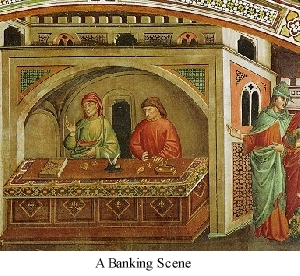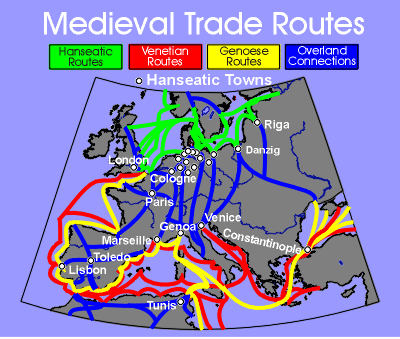The End of Europe's Middle Ages

During the eleventh and twelfth centuries, Europe enjoyed an economic and agricultural boom. A slight warming of the climate and improved agricultural techniques allowed lands that had previously been marginal or even infertile to become fully productive. In the late twelfth and early thirteenth centuries, however, the climate once again began to cool and agricultural innovations could not maintain the productivity of frontier lands that again became marginal or were abandoned entirely. The decreased agricultural output could no longer support the same level of economic activity and, as early as the middle of the thirteenth century, the economy was beginning to weaken. By early in the fourteenth century and continuing well into that century, a declining population, shrinking markets, a decrease in arable land and a general mood of pessimism were evidence of deteriorating economic conditions. This trend was far from universal and it was certainly less severe in northern Italy. Also, north of the Alps, some communities quickly rebounded and thrived on their commercial and manufacturing ventures. Coventry, England, for example, flourished with its woolen cloth industry while Bruges, in modern-day Belgium, was one of the major commercial centres of the North. In the early fourteenth century, Florence's textile industry and banking catapulted the city-state into the forefront of European enterprise and, eventually, into the Italian Renaissance. Significant private international banking and commercial ventures provided the foundation for many fortunes but even they succumbed to the recession that began in the fourteenth century.
 |
Banking in the Middle Ages |
The first half of the fourteenth century saw Europe burdened by overpopulation and the agricultural enterprises of northern Europe had reached the limits of their productivity. A lowered standard of living for the peasantry resulted from the ongoing subdivision of their land holdings or expansion into marginally productive areas. Poor weather in the early 1300's created meagre harvests and mass starvation was the result in some areas, eliminating as much as 15 percent of the population. Warfare had been virtually continuous and pauses in major international conflicts, such as the Hundred Years' War, were replaced with local confrontations.
 |
Famines of 1315-Johannes of Trowkelowe |
The expansion of long-distance trade and commerce seen in the twelfth and thirteenth centuries also began to dwindle at the end of the Middle Ages although some trade links, especially those in the Mediterranean and in northern Europe, had become sufficiently well established to resist shrinking markets. Trade continued across the Mediterranean from Venice, Florence and Genoa. Italian trade diasporas also existed in the Byzantine Empire as well as dotting North Africa and the Middle East. In northern Europe, the Hanseatic League dominated trade around the Baltic and North Seas from the late fourteenth century. Innovations in commercial accounting also continued to develop and double-entry bookkeeping spread from Genoa in the early fourteenth century. While the arrival of the Black Death through ports and major trade centres tended to restrict commercial contacts, trade links were not entirely severed.

The first sweep of the Black Death struck in 1347-1349, eliminating between one-third and one-half of Europe's population. Economic and social institutions were crippled by the severe depopulation. The immense loss of life cut across all levels of society and had a profound emotional effect on the survivors as outbreaks continued well into the seventeenth century.
 |
Black Death |
The devastation wrought by the Black Death on the people of Europe created a severe shortage of labour. Where land had previously been overworked in order to support large populations, there was now an abundance of land for the survivors. The peasant and working classes were no longer populous and were able to demand higher wages. Landlords, faced with the prospect of crops rotting in the fields or idle machinery, had no choice but to pay the increased prices. Caught between rising production costs and falling grain prices, many landlords rented out their lands and, as more serfs became tenant farmers, manorialism came to an end.
In the cities of Europe, urban populations tended to recover more quickly from the plague than rural communities. This led to large migrations into cities after plague outbreaks but many of these immigrants remained unemployed. The gap between the rich and the poor widened as the elite closed ranks to protect their holdings and positions. Close-knit and exclusive guilds were organized by occupation to regulate workers and eliminate outside competition.
 |
Southampton Guild Organization, Fourteenth Century. |
Attempts by the nobility and mercantile elite to legislate the wages and services of the peasantry and to protect their market monopolies led to violent revolts that were often ruthlessly suppressed. The French Jacquerie of 1358 was followed by the Florentine Ciompi Revolt in 1378 and the English Peasants' Revolt in 1381. Similar popular uprisings occurred in Germany, Spain and the Netherlands. Still, the ruling classes managed to maintain their power. Slowly, the economy began to recover from the devastations of the late 1300's and early 1400's, and by 1500, the economic crisis had passed, setting the stage for the flourishing of the Renaissance.
 |
Contemporary description of the Jacquerie. | |
 |
English Peasants' Revolt, 1381 |  |
The English Monarchy attempted to control the peasants' demands for higher wages by issuing the Ordinance of Labourers in 1349. The problem remained unresolved and despite the passing of the Statutes of Labourers in 1351, the situation continued to be extremely contentious until the Peasants' Revolt erupted in 1381. |
 |
Return to the Home Page | Proceed to Feudal Institutions |  |
The End of Europe's Middle Ages / Applied History Research Group / University of Calgary
Copyright © 1997, The Applied History Research Group